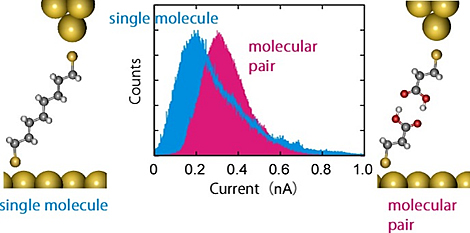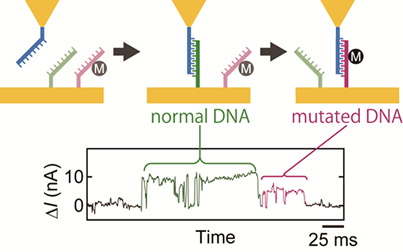Research
Single-molecule chemistry
Molecules exhibit a rich variety of chemical characteristics and physical properties. By placing a single molecule between metal electrodes, it is possible to directly measure the properties of the single molecule and utilize its functions. By adding another single molecule of a different kind to the single molecule between the electrodes, a molecular pair consisting of two bonded single molecules is formed, such that these molecules cooperate, leading to a new unit with potentially new and unique functions.
A single molecule in contact with the metal electrodes at two locations functions as a low-dimension nanoscale substance; as such, it is considered a new phase of matter. Therefore, such a single molecule displays properties not found in bulk materials on the macroscopic scale, including unique electronic, optical, and thermal properties. By measuring a single molecule, it is possible to clarify organic electronic devices, such as organic EL and organic solar cells; photosynthesis and other important fundamental processes of mass transport and energy conversion in biological systems at the molecular level.
Because of interest in the above-mentioned properties, we are researching the single-molecule chemistry of a variety of molecules in order to search for distinctive material properties and develop the functions of these single molecules and single-molecule pairs trapped between metal electrodes. Research on these topics could lead to the development of revolutionary single-molecule reactions, low-energy-consumption high-functioning computers based upon single molecules, and high-sensitivity sensors capable of detecting single molecules. Finally, we aim to create a new academic discipline, single-molecule chemistry.

Schematic diagram of a single molecule bridging two metal electrodes, cover illustration of PCCP.
Observing a single molecule
A single molecule cannot be observed using a conventional optical microscope. Therefore, we are exploring new techniques to visualize single molecules. To observe molecules trapped between electrodes, it is necessary to determine the number and type of the molecules. To determine the molecular type, we have focused on the weak changes in conductivity caused by the interactions between electrons flowing in a junction and molecular vibrations. By measuring the dependency of the conductivity on the voltage between the electrodes, we have determined the vibrational energy of a molecule, thereby determining its type. To determine the number of molecules, we have also focused on the fluctuation of conductivity. At the single atom/molecule scales, the flow of electrons becomes discrete. This discretized flow of electrons can be represented as the function of the transmission of the electrons at the junction, and by combining it with conductivity measurements, it is possible to determine the absolute number of bridged molecules. The figure shows the simultaneously obtained vibrational spectroscopy and noise measurements for a single-molecule junction; this is the world's first reported successful measurement of this kind. This benzene system is interesting in that when a benzene molecule, which is an insulator in bulk, is isolated within such a junction, it conducts as much electricity as a metal. This finding can be explained as a unique physical property of a single-molecule junction.

Structure determination of a benzene single molecule junction.
Building an electronic component with a single molecule
If a single molecule could be given a specific device function, building devices that are both ultrasmall and consume infinitesimally small amounts of electric power would be possible. Reducing the sizes of devices permits greater integration, resulting in dramatic improvements in computer performance. Also, single-molecule devices would provide another benefit: the ability to freely design device functions based on well-developed synthetic chemistry. We have successfully developed single-molecule switches and diodes in order to realize single-molecule devices. To develop a single-molecule switch, we successfully changed the electric resistance in steps by applying mechanical force to modulate the contacts between the metal electrodes and the molecule in question. To develop a single-molecule diode, we layered donor and acceptor molecules in a caged molecule to manifest rectification properties. In particular, we succeeded in freely designing these functions by using caged molecules to vary the layered molecules without changing the molecular size.

Development of a single-molecule device permitting the free design of single-molecule switches and functions.
Using molecular pairs
By carefully placing two different types of molecules in contact between a pair of metal electrodes, it is possible to form a single-molecule pair or, in other words, a double-molecule junction. Many functional materials created through previous developments in chemistry and astonishingly fine, high-functioning biological materials have manifested their functions through the interaction of different types of molecules. Therefore, carefully using molecular interactions in double-molecule junctions can create nanoscale and molecular scale functional devices. Based on a technique called molecular tips, we systematically fabricated double-molecule junctions and studied the diverse functions they displayed. We have already verified switches, diodes, etc. made of only two molecules in junction structures and aim to develop more high-functioning devices in the future.

Measuring electron transfer within double-molecule junction.
Detecting single biomolecules
Supramolecular host molecules or receptors inside living organisms recognize and bond only with certain, specified molecules. We applied double-molecule junctions to molecular-recognition chemistry of this kind to develop a method to selectively and directly measure only single molecules. As an example, we developed a method of detecting a single molecule of DNA. When DNAs are first fixed between metal electrodes, a molecular junction is formed, inducing electron transfer only when there is DNA complementary to this DNA, thereby achieving single-molecule detection. This conductivity is extremely sensitive to the composition of DNA, so it permits the detection of mutations or damage to the DNA, both of which are causes of various conditions, including cancer and aging. Using this technology, it may be possible to use a single molecule of DNA to perform genetic testing. We are developing single-molecule detection methods for a variety of biomolecules and biological signals.

The single-molecule detection of mutated DNA.
